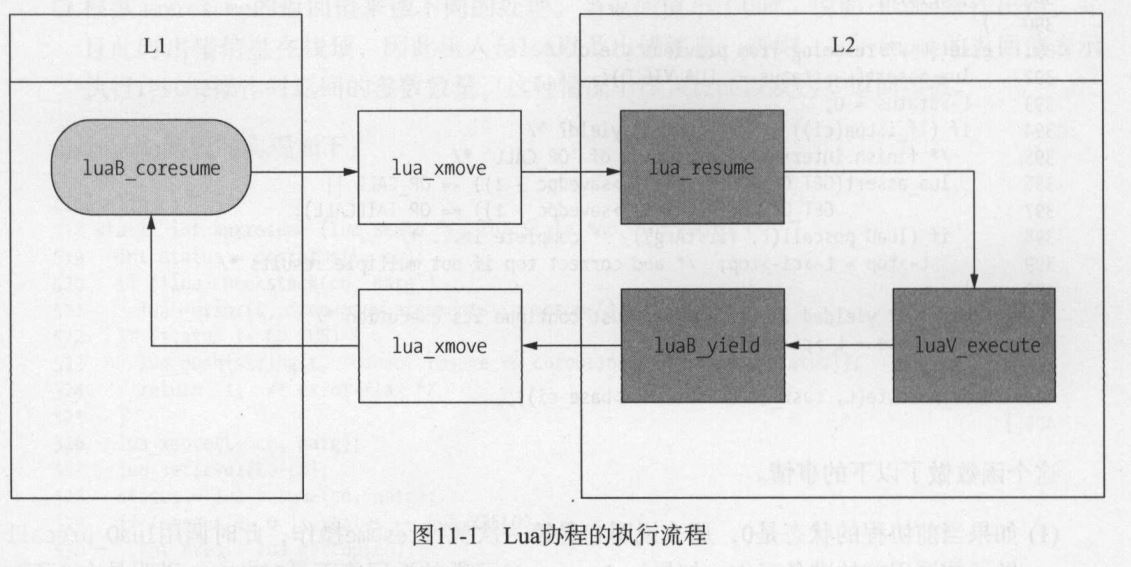协同程序与线程差不多,也就是一条执行序列,拥有自己独立的栈、局部变量和指令指针,同时又与其他协同程序共享全局变量和其他大部分东西。
一个具有多个协同程序的程序在任意时刻只能运行一个协同程序。
lua将所有关于协同程序的函数放置在一个名为“coroutine”的table中。
一个协同程序可以处于4种不同的状态:挂起、运行、死亡和正常。
程序初创建:挂起
程序运行:运行
程序结束:死亡
程序被其实程序唤醒:正常
co_create传一个函数参数,用来创建协程。返回一个“thread”对象:
1
2
3
4
| co = coroutine.create(function (a,b)
coroutine.yield(a+b,a-b)
end)
print(coroutine.resume(co,20,10))
|
与协同程序之间的对称性区别相比,协同程序与generator(Python所提供的)之间的区别很大。
实现
协程实现的两个关键点在于:
在Lua代码中,使用的是lua_State结构体来表示协程,这与Lua虚拟机用的是同一个数据结构 。 这一点可以从创建协程的函数lua_newthread中看出来,唯一有区别的是, Lua协程的类型是LUA_TTHREAD。 换言之,在Lua源码的处理中, Lua协程与Lua虚拟机的表现形式并没有太大差异,也许这样做是为了实现方便。 前面提到过,一个协程有自己私有的环境,不会因为协程的切换而发生改变 。
1
2
3
4
5
6
7
8
9
10
11
12
13
14
15
16
17
18
19
20
21
22
23
24
25
| LUA_API lua_State *lua_newthread (lua_State *L) {
lua_State *L1;
lua_lock(L);
luaC_checkGC(L);
L1 = luaE_newthread(L);
setthvalue(L, L->top, L1);
api_incr_top(L);
lua_unlock(L);
luai_userstatethread(L, L1);
return L1;
}
lua_State *luaE_newthread (lua_State *L) {
lua_State *L1 = tostate(luaM_malloc(L, state_size(lua_State)));
luaC_link(L, obj2gco(L1), LUA_TTHREAD);
preinit_state(L1, G(L));
stack_init(L1, L);
setobj2n(L, gt(L1), gt(L));
L1->hookmask = L->hookmask;
L1->basehookcount = L->basehookcount;
L1->hook = L->hook;
resethookcount(L1);
lua_assert(iswhite(obj2gco(L1)));
return L1;
}
|
接下来,我们来看看如何在不同协程之间通信,或者说Lua协程间数据的交换。 前面提到过resume和yield函数的参数就是用来做协程数据交换的,现在来看看里面的实现 。 奥秘就在函数lua_xmove中。
1
2
3
4
5
6
7
8
9
10
11
12
13
| LUA_API void lua_xmove (lua_State *from, lua_State *to, int n) {
int i;
if (from == to) return;
lua_lock(to);
api_checknelems(from, n);
api_check(from, G(from) == G(to));
api_check(from, to->ci->top - to->top >= n);
from->top -= n;
for (i = 0; i < n; i++) {
setobj2s(to, to->top++, from->top + i);
}
lua_unlock(to);
}
|
这段代码做的事情就是,从from协程中移动n个数据到to协程中 。 当然在移动之前,数据要在from协程的栈顶上准备好。
创建协程在函数luaB _cocreate中进行.
1
2
3
4
5
6
7
8
| static int luaB_cocreate (lua_State *L) {
lua_State *NL = lua_newthread(L);
luaL_argcheck(L, lua_isfunction(L, 1) && !lua_iscfunction(L, 1), 1,
"Lua function expected");
lua_pushvalue(L, 1);
lua_xmove(L, NL, 1);
return 1;
}
|
了解了Lua协程实现相关的数据结构,接下来看看最核心的两个操作resume和yield是如何实现的 。
resume操作在函数luaB_coresume中实现:
1
2
3
4
5
6
7
8
9
10
11
12
13
14
15
16
| static int luaB_coresume (lua_State *L) {
lua_State *co = lua_tothread(L, 1);
int r;
luaL_argcheck(L, co, 1, "coroutine expected");
r = auxresume(L, co, lua_gettop(L) - 1);
if (r < 0) {
lua_pushboolean(L, 0);
lua_insert(L, -2);
return 2;
}
else {
lua_pushboolean(L, 1);
lua_insert(L, -(r + 1));
return r + 1;
}
}
|
auxresume函数的实现如下:
1
2
3
4
5
6
7
8
9
10
11
12
13
14
15
16
17
18
19
20
21
22
| static int auxresume (lua_State *L, lua_State *co, int narg) {
int status;
if (!lua_checkstack(co, narg))
luaL_error(L, "too many arguments to resume");
if (lua_status(co) == 0 && lua_gettop(co) == 0) {
lua_pushliteral(L, "cannot resume dead coroutine");
return -1;
}
lua_xmove(L, co, narg);
status = lua_resume(co, narg);
if (status == 0 || status == LUA_YIELD) {
int nres = lua_gettop(co);
if (!lua_checkstack(L, nres))
luaL_error(L, "too many results to resume");
lua_xmove(co, L, nres);
return nres;
}
else {
lua_xmove(co, L, 1);
return -1;
}
}
|
auxresume函数会调用lua resume函数,在lua resume函数中进行一些检查,比如当前的状态是否合理,调用层次是否过多,最终使用luaD_rawrunprotected函数来保护调用resume函数 。
resume函数的代码如下所示:
1
2
3
4
5
6
7
8
9
10
11
12
13
14
15
16
17
18
19
20
21
22
23
| static void resume (lua_State *L, void *ud) {
StkId firstArg = cast(StkId, ud);
CallInfo *ci = L->ci;
if (L->status == 0) {
lua_assert(ci == L->base_ci && firstArg > L->base);
if (luaD_precall(L, firstArg - 1, LUA_MULTRET) != PCRLUA)
return;
}
else {
lua_assert(L->status == LUA_YIELD);
L->status = 0;
if (!f_isLua(ci)) {
lua_assert(GET_OPCODE(*((ci-1)->savedpc - 1)) == OP_CALL ||
GET_OPCODE(*((ci-1)->savedpc - 1)) == OP_TAILCALL);
if (luaD_poscall(L, firstArg))
L->top = L->ci->top;
}
else
L->base = L->ci->base;
}
luaV_execute(L, cast_int(L->ci - L->base_ci));
}
|
yield操作在函数lua_yield中进行:
1
2
3
4
5
6
7
8
9
10
| LUA_API int lua_yield (lua_State *L, int nresults) {
luai_userstateyield(L, nresults);
lua_lock(L);
if (L->nCcalls > 0)
luaG_runerror(L, "attempt to yield across metamethod/C-call boundary");
L->base = L->top - nresults;
L->status = LUA_YIELD;
lua_unlock(L);
return -1;
}
|
这个函数做的事情相比起来就简单多了,就是将协程执行状态至为YIELD,这样可以终止luaV_execute函数的循环。

从lua-5.1.1中分离出来的协程实现代码
lthread.c
Quien siembra vientos , recoge tempestades.